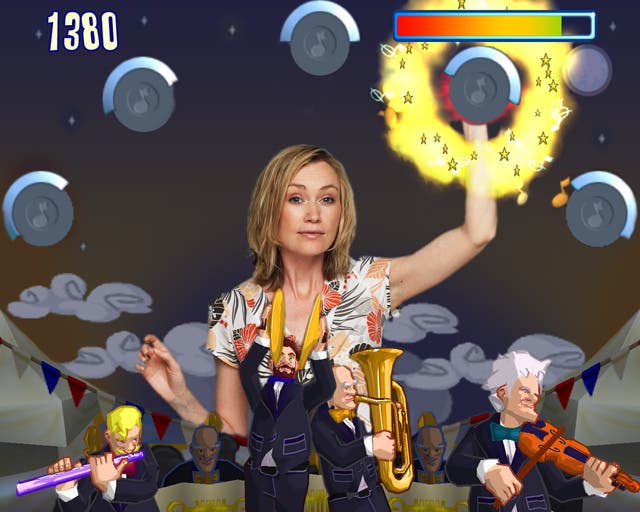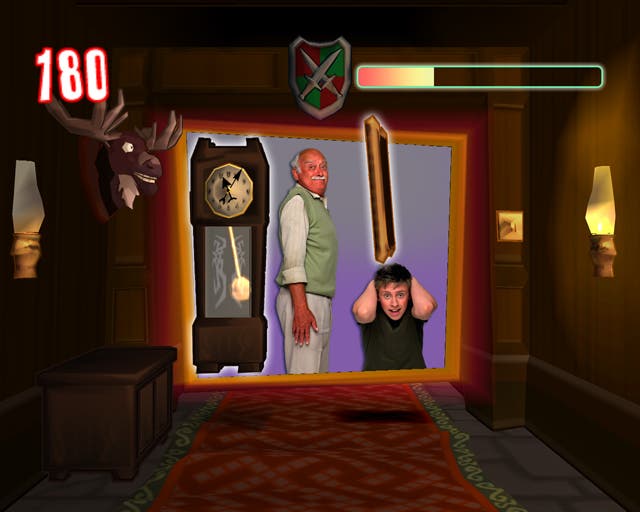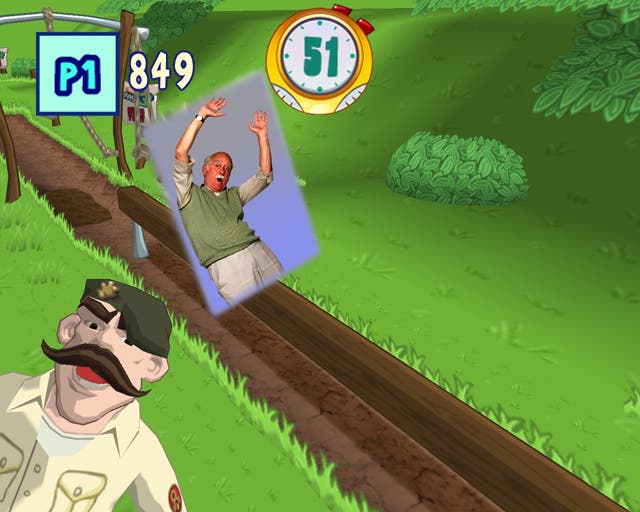EyeToy: Play 3
Sony is watching you. AGAIN.
So. Binge drinking then. The government says it's a bad thing and no mistake, and they're going to get the rozzers on anyone who does it. Apparently, people who drink are outcasts from righteous society and smell, to boot.
Personally, I disagree. As far as I am concerned, without booze, there would be no EyeToy. Disregard any of Sony's "it's for children" nonsense. The correct state of alcohol-induced instability is vitally important for a successful EyeToy play.
EyeToy Play 3 is the third mini-game-fest for the nifty auto-surveillance trinket, and the sixth or so game overall to use a fuzzy outline of me on my tellybox as the primary control system. The games have always been energetic, frantic and fun, and they're always, with this game being no exception, aimed squarely at The Kids. Which is fine, because I'm sure they love it.
But it's also a missed opportunity.
You see, EyeToy games, despite narrowly successful branding and marketing are not only suited for children. Pointing to the fact that kids (rightly) love playing them is not enough. The simple joy of making an arse of oneself is sadly lost on the average child, being as they are far too lacking in the repression and hang-ups of the fully deformed human adult.
No, EyeToy games should be aimed squarely at guffawing cells of urban twentysomethings, braying piercingly at their own indignant lack of self-consciousness, fortified by a piquant Cabernet Sauvignon or two, embracing some elaborate middle-class bonding ritual of the Vinopolis set. Lacking any friends from such elite circles, I grabbed the nearest second-tier chum I could find, knocked back whatever beerish substrate was mouldering in my fridge and did my best.

Play 3 follows the trend set by the first two games, and emerges like a blushing bride squarely from the current crowded transept of the Church of Mini-game. To anybody who was at first a big fan of mini-game-only game packages, but like myself has found them curiously unsatisfying of late, the flaws of this game will already be obvious in advance.
The problem seems to be that there are only so many mini-games anybody can think of. A game that you can pick up in seconds needs to have a simple concept and even simpler controls. And they've all been done already. Although there are "dozens" of games in the package, there are really only three or four games, and the rest are all variations on a theme, with different music and animation.
This problem is further compounded by having a "novel" control system like the EyeToy, which whilst adding novelty to the gaming canon as a whole, has the opposite effect of limiting the opportunity for novelty in the games themselves. So, the same five or six themes that have served the EyeToy franchise so well until now are all present and correct; the basic variations that established themselves in Play, and have recurred once before, return again in this third identikit outing.
As a result, anybody who has played EyeToy Play 1 or 2 will almost certainly find the game alarmingly familiar without the cushioning benefit of inebriation.

What of the games themselves?
Well, they are broadly divided into Sports, Music and the miscellany-of-evils that is unhelpfully labelled 'variety'. Under each of these three categories, there are three subdivisions, mini-games within mini-games, so to speak.
All of which means that, although the box may claim to offer "dozens" of new games, it really only offers you nine, repeated in slightly altered form across the three categories of Sport, Music, Other. Which can quickly become a disappointment once the beers start to run dry.
As is invariably, unavoidably, inevitably the way when your franchise hangs on mini-games, the games themselves are highly varied in both quality and fun. The "sports" category contains such staples as bowling, volleyball and "touchdown". Bowling is, despite being twitchy and hard to control in all but the most perfect of lighting, probably the most fun gamelet in the package. The simple act of aligning yourself within the ball and then flapping at the pins is simple enough to be immensely enjoyable.

The volleyball toy is equally simplistic, if significantly less fun, requiring little more than correct timing of a jump to blat the ball over the net. It requires little skill, but is quite exhausting in a short period of time. The third and, sadly, final sports game is "Touchdown" and is a drab affair that involves ducking, jumping, punching the "enemy" as they run at you, and trying to get a clear run at a touchdown.
Given how inspired EyeToy: Groove was, it comes as a rather unpleasant shock to discover that the music games in Play 3 are significantly substandard. The three games, despite being titled differently, are really all the same thing. It's basically waving your hands over an on-screen instrument in time with the music. This idea has been done better so many times before that these three mini-games can only be viewed as hugely disappointing.
The final category, the atrium of abandoned half-ideas, the hallway of lost dreams, is the category called "variety". Your options here start with "boot camp", a game which runs the gamut of running, jumping and ducking. Basically, it's exactly the same as "Touchdown", making one or the other quite pointless. The "salon" involves the comical cutting of hair by waving your arms in the EyeToy field of view, and is briefly distracting. The final mini-game in the variety category is "Ghost Hunt", which is a great deal like "Kung Foo" from Play 1 / 2. Only less fun.
Okay, so the games are still somewhat addictive; but you do have to sit through a lot of boring stuff to get to the good stuff. And in that, the kids at whom this game is aimed will be just as bored as the boozed-up twenty-somethings that have decided that a spot of EyeToy would be a jolly jape. As a critical example, take the bowling. If you want to play successive bowling games, then you must complete the training and basic games first. The game doesn't allow you the option of jumping to that part of the mini-game you wish. You must play it all. Which means you simply won't bother.

As is standard for EyeToy games, the graphics in the game are basic, but homely. EyeToy games always had a distinct look and this game is no different. The camera quality remains sufficient but ultimately quite poor. As an EyeToy fan, being an apologist for its failures comes naturally to me.
Ultimately, this game's great failing is one of identity. It's a game that adults could enjoy, but may never get the chance because it's aimed squarely at children. Hundreds of Islington dinner parties will never come to sufficient closure because of this marketing oversight, and that's a pity.
Perhaps even more significantly, this game has an identity problem even among its peers. If you want an EyeToy game that is musical, rhythmical, and gives you that genuine Dance Mat moment, you'd be better off playing EyeToy: Groove. If you want an EyeToy game that is fast, frantic, energetic and sporty, you'd be better of playing EyeToy: Kinetic. If you want to play a range of fun and silly mini-games on your EyeToy, well, then you already have EyeToy: Play and Play 2. Why would you need yet another?
That is this game's great failing. While it is fun, although not magnificently so, in its own right, it fails to offer a convincing reason to buy it over the many other fine EyeToy outings that have gone before. I'd suggest you put down the wine for a second, and seek one of those out instead.







